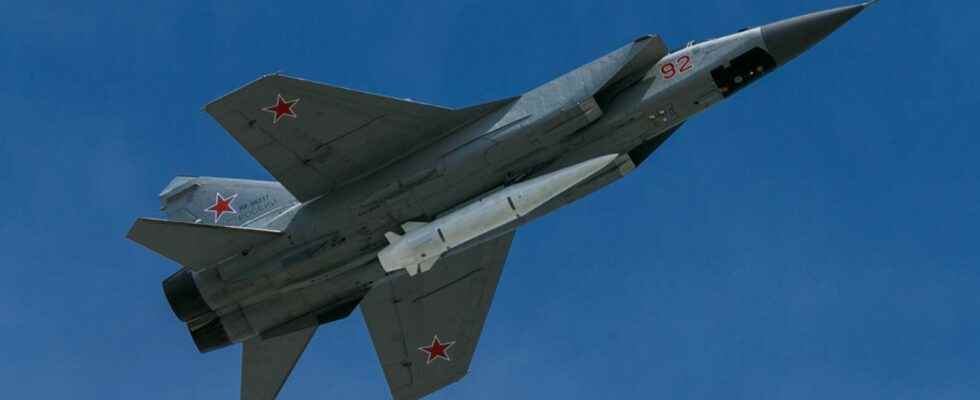You will also be interested
[EN VIDÉO] What is the most powerful nuclear bomb in history? On October 30, 1961, a 57 megaton atomic bomb exploded over the site of Novaya Zemlya, Russia. Baptized Tsar Bomba, it is the most powerful bomb in history.
While the Russian offensive in Ukraine bogged down, the government of Vladimir Putin provoked the concern of the international community by declaring that the army had targeted two Ukrainian positions with “hypersonic” missiles. On March 19, 2022, a powerful strike destroyed an ammunition depot near the Romanian border, in western Ukraine, while a second missile fell on a fuel depot, not far from Mykolaiv, in the south. from the country. Both attacks mark the first use of hypersonic munitions in a military theater, garnering media and expert attention. The Russian Kh-47M2 Kinzhal hypersonic missiles are theoretically capable of reaching Mach 9 and traveling 2,000 kilometers, potentially making a large number of targets reachable over a great distance.
The Kinzhal, one of Russia’s hypersonic missiles
By definition, a supersonic missile is capable of exceeding Mach 5, 6,174 km/h, i.e. five times the speed of sound (1,234.8 km/h). at thedawn 2000s, many military powers began modernization of their equipment, including the United States, China and Russia. The Kinzhal (or Kinjal, “dagger” in Russian), is part of this new generation of ammunition. The architecture of the Kinzhal is based on the Iskander, a system composed of two ballistic missiles (M and E) and a cruise missile (K), of short and medium range, developed by the Soviet Union from the end 1980s and commissioned in 2006.
Unveiled in 2018, the Kinzhal is an air-to-surface type munition, deployable from two aircraft, the MiG31 fighter-interceptor and the Tupolev Tu22M, a supersonic bomber. The Russian “dagger” can carry out so-called conventional strikes, as observed on March 19 near Ivan-Frankiskv and Mykolaiv, but also has the capacity to carry nuclear warheads. The high speeds reached by a Kinzhal missile make its interception almost impossible and complicate its detection, being in fact more unpredictable.
Russia has two other hypersonic weapons: the 3M22 cruise missile Zirconlaunched from land or a ship, as well as the glider Avangard (or Yu-74), meanwhile, sent with a ballistic missile. Both Zircon and Avangard are maneuverable, giving them an additional ability to evade defensive systems.
Hypersonic weapon: what risks?
Shortly after the announcement by the Russian Ministry of Defense regarding the use of two Kinzhal missiles, concern stormed the social networks, fueled by numerous alarmist articles. The technical characteristics of the ammunition and the primacy of its use by the Russian forces have resurrected fears of the Cold War, in the face of the risk that a conflict between the military powers of NATO and Russia would represent. Russia’s posture is intended to be intimidating regarding its military capabilities: Vladimir Putin and his subordinates have waved the card of the (barely veiled) nuclear threat during various speeches and the strong presence of the army in the enclave of Kaliningrad is a point of pressure extra for the Kremlin.
Nevertheless, while Russia prides itself on the use of Kinzhal missiles, the political scientist and editor of International Defense and Security (ISD), Joseph Henrotinrecalled on Twitter that “ the hypersonic quality of the Kinzhal is questionable”. Of many experts explain that the use of such ammunition by Russia could be due to the depletion of stocks of Iskander ballistic missiles, a test in the field, or an attempt to harden the tone on the part of Moscow, while the conflict is gradually turning against Russia. In addition, a video published by the Russian Defense Ministry showing the strike on the ammunition depot in the west of the country turned out to be false, showing in reality a missile launch on a military base located in the Donbass.
This weekend the Russian Ministry of Defense communicated on a Kinzhal hypersonic missile launch, targeting an ammunition warehouse in western Ukraine one hundred kilometers from the Romanian border. But that’s not what the video shows. [1/3] pic.twitter.com/peD1NnDDF5
— Defakator (@DEFAKATOR_Off) March 21, 2022
NATO estimated on March 15 that more than 700 strikes had been carried out by Russia since the start of the invasion on February 24. In a month of war, many important cities such as Kharkiv or Mariupol were devastated by intense Russian strikes. According to the United Nations, nearly 1,000 civilians have been killed since the start of the conflict.
Interested in what you just read?
